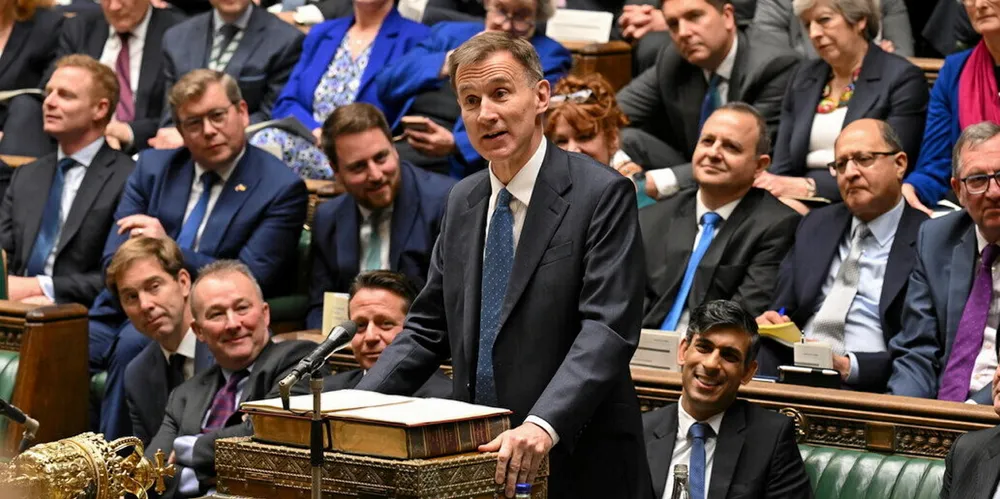UK addresses pylon protests with sweeteners, but are green industry measures 'too little, too late'?
Extending tax break on capital goods is questioned as a response to the increasingly competitive race for clean tech investments

The UK has introduced measures to foster faster development of electricity infrastructure in the government's Autumn budget statement, amid growing concerns that the country’s renewables ramp-up could result in a log-jam unless grid connection times are cut.
They included measures to address growing opposition to the construction of electricity infrastructure in areas such as rural eastern England where rapid growth in offshore wind farms has exposed looming grid bottlenecks. Some local groups have expressed fierce opposition to the visual and environmental impacts of the grid infrastructure investments.
Households living close to new transmission pylons and substations will now get £10,000 off their electricity bills over a decade, Hunt confirmed when he made his budget statement to the UK parliament today (Wednesday).
The measures announced by Hunt included government commitments to reform the planning system by offering local authorities financial incentives to make decisions faster.
The queue to gain access to the UK grid can currently run to extremes of 14 years, but Hunt predicted that compensation packages and other mitigation steps will cut the wait by 90%.
The UK’s National Grid utility has stated that the country needs to build five times as much grid infrastructure over the next seven years as was built in the previous 30 years.
"Reforms which facilitate grid expansion and connections are a very positive step given that grid infrastructure underpins a very significant proportion of the technologies being taken forward to achieve Net Zero," commented Michael Burns, partner and global co-head of energy at London law firm Ashurst.
The UK’s energy entities have been moving to address the grid bottlenecks in other ways in recent weeks, coming up with mitigation measures purporting to free up 50GW of grid capacity to allow generators and battery storage providers to connect substantially earlier than previously estimated.
These include new queue management measures introduced by National Grid's electricity system operator (ESO), new rules introduced by energy regulator Ofgem to reward those able to achieve faster grid connections and three-point connections plan by the Energy Networks Association (ENA).
Lawrence Slade, CEO of ENA, commenting ahead of Hunt's budget statement, said the sector, along with government and regulators was making "huge efforts to remove the barriers to connect to the grid faster.
"However, this is only the beginning and it’s essential the government continues to work to make it easier for vital energy infrastructure to be built. Technical and legal changes will get us so far, but more infrastructure is going to be needed if we are to meet the UK and Scottish governments’ respective net zero targets.”
The UK government has set a legally binding target of 2050 for the country to reach net zero, while the Scottish Government has set 2045 as the target for Scotland.
John Pettigrew, chief executive of National Grid, said the new planning proposals would bring "clarity, authority and urgency to what needs to be built and where" but will also "ensure local people remain at the heart of the energy transition.
"The connections action plan will deliver fundamental reforms needed to enable us to plug clean energy projects in faster, and build on the progress already being made," he stated.
Tax claw-back
The budget statement included £3bn ($3.75bn) over five years for investment in green industry, including £1bn for hydrogen, CCS, nuclear and offshore wind.
In another move of potential importance for the renewables and clean tech sectors, Hunt extended a 100% tax claw-back for plant and machinery that was introduced as a temporary measure and was due to expire in 2026.
This was interpreted in some quarters as a partial response to US incentives for clean tech investment in the shape of the Inflation Reduction Act, with this longer term tax framework likely to suit network investments.
Investment in capital goods has been running far below the historical norm in the UK even with the temporary tax break.
E3G, a think tank on climate change economics, argued that £3bn of additional green industry spending "will hardly make a difference in keeping the UK competitive" in the green economy.
Ed Matthew, campaigns director at E3G said: “The UK has fallen behind the US, EU and China in clean tech investment and the announcements today are not enough to get us back in the race. Whilst reforms to speed up grid connections and boost funding for green industry are helpful, there is no credible net zero investment plan and no green industrial strategy. This response is incoherent, too little and too late.”
Backtracking claims
Commenting on the impact of the new budget measures on energy and net zero ambitions, Peter Chalkley, director at the Energy and Climate Intelligence Unit (ECIU) said: “We’ve now got the Chancellor entering the global race to incentivise clean industries to set up here, rather than elsewhere.
"But with business leaders, most politicians and the public alike seeing clean as the next big thing, and with the US, EU and China already powering ahead, does this risk looking too little, too late?"
Lobby group RenewableUK was more positive, with CEO, Dan McGrail welcoming the decision to make the capital goods tax incentive more permanent as providing "a much-needed degree of long-term certainty for investors in green technologies, helping to make the UK an attractive destination for investment in clean energy projects and manufacturing".
McGrail also welcomed what he described as a government ambition to cut grid connection delays from several years to six months.
(Copyright)